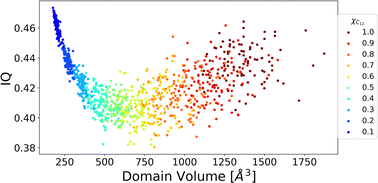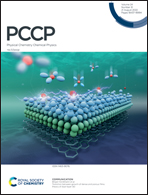The structuring effect of the alkyl domains on the polar network of ionic liquid mixtures: a molecular dynamics study†
Abstract
By using molecular dynamics simulations, we investigate the structural and dynamic properties of mixtures of 1,3-dimethylimidazolium bis(trifluoromethanesulfonyl)imide, [C1C1im][Tf2N] and 1-dodecyl-3-methylimidazolium bis(trifluoromethanesulfonyl)imide, [C12C1im][Tf2N] (also C1 and C12 in short). Such mixtures feature an imidazolium bistriflimide salt with a very short alkyl chain, not giving rise to any nano-segregation as a pure component, with another one with a longer alkyl chain that exhibits a substantial nano-segregation as a pure liquid. As the mole fraction of the long-chain component C12 is increased, the so-called pre-peak of the structure factor S(q), occurring in the region 1–3 nm−1, shows a shift to higher values of the wavevector q, mirroring a decrease of the corresponding correlation length. Moreover, the intensity of the pre-peak strongly increases with the C12 concentration. These results are in very good agreement with experimental X-ray scattering data in the literature. On the other hand, the diffusion of the ions is found to exhibit a simple behaviour consistent with the increased viscosity of the mixture, and these results are also in good agreement with NMR experimental data from the literature. The simulation results are rationalized as caused by a structuring effect, similar to the hydrophobic effect, of the alkyl domains of the C12 component dissolved in the “solvent” represented by the C1 cation, the Tf2N− anion and the C12 cation head. In short, the exclusion of the alkyl chains from the polar network, a process mostly governed by electrostatic interactions, favours the formation of hydrophobic domains, which in turn exert a structuring effect on the ions of the polar domains, favouring a stronger ionic interaction. This is finally reflected in a shorter correlation length and a higher intensity of the pre-peak of the structure factor S(q) as the C12 mole fraction is increased. At variance with the microscopic structure, the diffusion of all three types of ions is not strongly influenced by the nano-segregation and is essentially dependent on the viscosity of the mixture.



 Please wait while we load your content...
Please wait while we load your content...